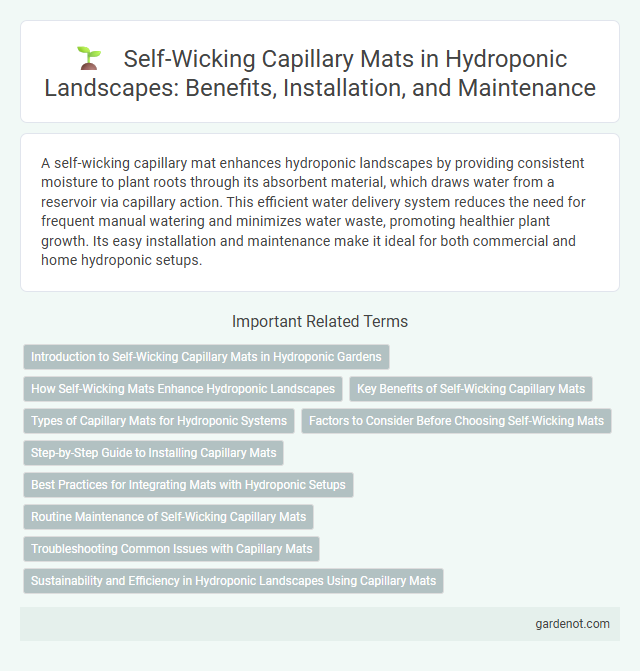A self-wicking capillary mat enhances hydroponic landscapes by providing consistent moisture to plant roots through its absorbent material, which draws water from a reservoir via capillary action. This efficient water delivery system reduces the need for frequent manual watering and minimizes water waste, promoting healthier plant growth. Its easy installation and maintenance make it ideal for both commercial and home hydroponic setups.
Introduction to Self-Wicking Capillary Mats in Hydroponic Gardens
Self-wicking capillary mats provide a consistent and efficient water delivery system in hydroponic gardens by utilizing capillary action to draw water from a reservoir directly to plant roots. These mats are composed of absorbent materials that maintain optimal moisture levels, reducing water waste and promoting healthier plant growth. Their ease of use and maintenance make them ideal for both small-scale and large hydroponic systems, enhancing overall irrigation efficiency.
How Self-Wicking Mats Enhance Hydroponic Landscapes
Self-wicking capillary mats improve hydroponic landscapes by providing consistent moisture directly to plant roots, reducing water waste and promoting healthier growth. These mats enable efficient nutrient delivery and maintain optimal humidity levels, critical factors in hydroponic systems. By simplifying irrigation management, self-wicking mats enhance plant vitality and overall system sustainability.
Key Benefits of Self-Wicking Capillary Mats
Self-wicking capillary mats provide consistent moisture delivery by automatically drawing water to plant roots, reducing the risk of overwatering and underwatering. These mats enhance water efficiency, minimizing waste and supporting sustainable hydroponic landscapes. Their easy installation and low maintenance make them ideal for both commercial and home hydroponic systems, promoting healthy plant growth and uniform hydration.
Types of Capillary Mats for Hydroponic Systems
Self-wicking capillary mats for hydroponic systems come in various types, including natural fiber mats like coconut coir and wool, synthetic mats made from polypropylene or polyester, and blended options combining both materials. Each type offers different water retention and wicking properties, with natural fibers providing superior moisture absorption and synthetic mats offering durability and resistance to mold. Selecting the right capillary mat depends on factors such as plant species, system design, and desired moisture levels within the hydroponic setup.
Factors to Consider Before Choosing Self-Wicking Mats
Selecting self-wicking capillary mats for hydroponic landscapes requires assessing water retention capacity, material durability, and compatibility with plant root systems. Consider factors such as permeability to ensure consistent moisture distribution and resistance to mold or algae growth under humid conditions. Evaluating thickness, size, and ease of cleaning will further optimize plant hydration and overall system efficiency.
Step-by-Step Guide to Installing Capillary Mats
Begin installing a self-wicking capillary mat by measuring the hydroponic system's base to cut the mat to the exact size needed for uniform moisture coverage. Place the mat directly beneath the growing trays or containers, ensuring full contact to maximize water absorption and distribution. Connect the mat's water source, typically a reservoir or drip irrigation line, and test the setup to confirm consistent self-wicking action throughout the hydroponic landscape.
Best Practices for Integrating Mats with Hydroponic Setups
Self-wicking capillary mats optimize water distribution by consistently delivering moisture to hydroponic plants' root zones, reducing water waste and promoting uniform growth. Implementing best practices such as selecting mats with high capillary action, maintaining proper mat saturation levels, and ensuring direct contact between the mat and the growing medium enhances nutrient uptake and prevents root diseases. Integrating these mats within hydroponic setups increases system efficiency by stabilizing moisture levels and supporting sustainable, low-maintenance plant cultivation.
Routine Maintenance of Self-Wicking Capillary Mats
Routine maintenance of self-wicking capillary mats in hydroponic landscapes involves regular inspection for algae buildup and debris that can obstruct water flow. Cleaning the mats with a mild bleach solution or warm water helps prevent mold growth and ensures uniform water distribution to plants. Replacing mats every 1-2 years maintains optimal capillary action and promotes healthy root hydration in hydroponic systems.
Troubleshooting Common Issues with Capillary Mats
Self-wicking capillary mats often face common issues such as uneven moisture distribution, leading to dry spots or waterlogging. Ensuring the mat maintains consistent contact with the growing medium and checking for blockages in water supply lines helps maintain optimal hydration. Regular cleaning and monitoring for algae buildup enhance the mat's efficiency in hydroponic landscapes.
Sustainability and Efficiency in Hydroponic Landscapes Using Capillary Mats
Self-wicking capillary mats enhance sustainability in hydroponic landscapes by reducing water waste through precise moisture delivery directly to plant roots, minimizing evaporation and runoff. These mats improve efficiency by maintaining consistent hydration levels, promoting healthier plant growth and reducing labor for irrigation management. Utilizing capillary mats supports eco-friendly practices by optimizing water usage and lowering the environmental footprint of hydroponic systems.
Self-wicking capillary mat Infographic

 gardenot.com
gardenot.com